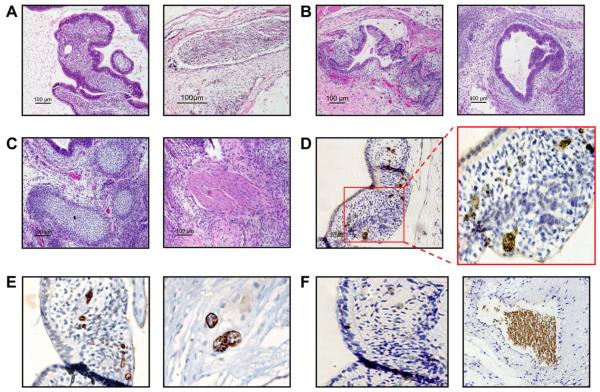Figure 2.
Detection of ectodermal, endodermal, mesodermal and primitive haematopoieic differentiation in xenografted pluripotent preimplantation genetic diagnosis-derived human embryonic stem cell line SC233 teratomas. Injection of SC233 into highly immunodeficient NOG mice gave rise to teratomas containing differentiated derivatives of all three embryonic germ layers. (A–C) Representative haematoxylin and eosin stains from mature, cystic SC233 teratoma sections demonstrate pluripotent differentiation to (A) ectoderm (neural differentiation), (B) endoderm (left panel, gut; right panel, respiratory epithelial), and (C) mesoderm (left panel, cartilage; right panel, muscle) (bars = 100 μm). (D) Rare areas of haematopoietic differentiation in mesodermal areas were detected in SC233 teratoma sections by in-situ immunostaining of adult haemoglobin-expressing erythrocytes (bar = 400 μm; right panel magnification 400×). (E) Associated CD34+ haemangioblastic structures in teratoma sections, many of which contained differentiating clusters of erythroid cells (left panel magnification 200×; right panel 400×). (F) Haematopoietic cells were confirmed to be human teratoma-derived cells (and not intermixed host murine erythroid cells) via virtue of negative staining for murine erythroid cell-specific Ter119 expression (left panel, magnification 200×). Strongly positive Ter119 staining of intermixed murine cells is shown in the right panel in an adjacent area of the same slide (magnification 200×).

